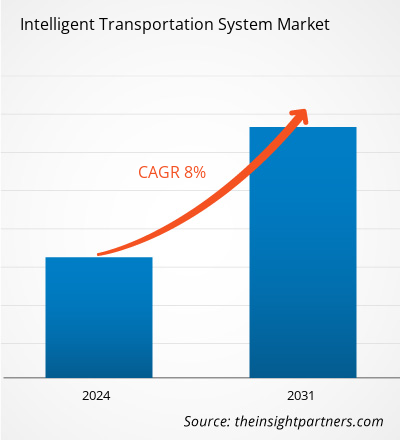インテリジェント交通システム市場規模は、2023年の359億3,898万米ドルから2031年には663億5,513万米ドルに達すると予測されています。市場は2023年から2031年にかけて8.0%のCAGRを記録すると予想されています。インテリジェント交通システム向けV2Xの実装は、予測期間中に新しいトレンドとして浮上する可能性があります。
インテリジェント交通システム市場分析
道路(都市インフラの重要な構成要素)は、人間の移動と物流を促進し、社会経済成長の基盤として機能し、都市、港、空港を結びます。道路の整備と開発は経済成長を促進しますが、交通量の増加は混雑や交通事故などの問題につながります。近年、車両所有の増加による悪影響は悪化しており、温室効果ガス排出による交通事故の大幅な増加や環境悪化につながっています。交通管理とインフラを改善するため、ITSは有線および無線接続に基づく幅広いICTを活用します。輸送リスクの低減、交通渋滞の緩和、輸送効率の向上、汚染の低減、運転体験、道路システムの安全性と容量の向上を実現します。最先端の通信技術を輸送インフラと車両に統合することで、ITSは生産性を高め、輸送におけるモビリティと安全性を向上させ、グローバルなつながりを強化します。そのため、今後数年間でITSの需要は増加すると予想されています。インテリジェント交通システム(ITS)市場は、スマートシティイニシアチブとインフラ開発の増加、地域をまたいだ急速な都市化、そして道路の安全性を高めるための政府の取り組みによって主に推進されています。さらに、政府機関が輸送インフラの改善に注力していることから、予測期間中に市場に有利な機会が生まれると予想されます。しかし、システム統合の課題、サイバーセキュリティの脅威、そして高額なメンテナンスコストが市場の成長を阻害する要因となっています。
インテリジェント交通システム市場概要
インテリジェント交通システムは、最先端の無線、電子、自動化技術を用いて、交通ネットワークを監視、評価、制御します。情報通信技術(ICT)を用いて自動車と交通インフラを接続します。このように、無線デバイス、センサー技術、そしてスマートICTサービスの利点が、ITSの導入の急増につながっています。さらに、ITSは、通行料徴収、商用車の運行、交通管理、旅行者情報、公共交通機関など、交通の流れを改善し、衝突を防止し、乗客の快適性と安全性を高めるために、様々な用途に活用されています。
要件に合わせてレポートをカスタマイズ
レポートの一部、国レベルの分析、Excelデータパックなどを含め、スタートアップ&大学向けに特別オファーや割引もご利用いただけます(無償)
インテリジェント交通システム市場: 戦略的洞察

-
このレポートの主要な市場動向を入手してください。この無料サンプルには、市場動向から見積もりや予測に至るまでのデータ分析が含まれます。
インテリジェント交通システム市場の推進要因と機会
地域をまたぐ急速な都市化が市場成長を促進
従来の交通インフラは、資源配分、汚染制御、交通渋滞の面で非効率であると認識されています。通勤者数と車両所有数の増加により、インテリジェントなソリューションと交通管理技術の向上に対する継続的なニーズが生じています。ITSは、自動駐車、スマート信号、公共交通機関のリアルタイム追跡を支援します。交通管理は、都市計画と開発において重要な側面です。国連欧州経済委員会(UNECE)によると、2050年までに世界人口の55%が都市部に居住すると予想されています。さらに、世界銀行によると、世界人口の56%、つまり44億人が現在都市部に居住しています。この傾向は今後も続くと予想され、2050年までに都市人口は過去最高に達し、10人中7人近くが都市部に居住する可能性があります。都市が世界のGDPの80%以上を生み出していることを考えると、適切に管理された都市化は生産性を高めることで持続可能な成長を促進できます。したがって、都市の拡大と開発は、インテリジェントな交通システム市場の成長を押し上げます。
政府の交通インフラへの重点
世界中で、地下鉄施設、新しい空港、鉄道網の建設が増加しています。2023年3月、カナダのケロウナ市議会は、ケロウナ空港ターミナル拡張プロジェクトへの9,000万米ドルの資金提供を承認しました。2023年現在、米国では6つの新しい空港が建設中です。2022年、インド政府は2025年末までに220の空港を建設する計画を発表しました。2023年、インド政府は接続性を高めるために7つの変革的な鉄道プロジェクトに39億3,000万米ドルを承認しました。2021年11月、米国議会は1,100億米ドルを投資して全国の道路と橋を修復および再建するための超党派インフラ協定を可決しました。気候変動の緩和、回復力、公平性、すべてのユーザーの安全性に焦点を当てることにより、この投資は、今後5年間で国内の劣悪な道路や高速道路を変革することを目指しています。2023年3月の米国大統領とカナダ首相の共同声明によると、カナダ重要鉱物インフラ基金の下で、クリーンエネルギーと交通インフラプロジェクトを支援するために約10億9000万米ドル(15億カナダドル)が投資される予定です。したがって、世界中で増加するインフラ開発プロジェクトは、予測期間中にITS市場の成長にとって有利な機会を生み出すと予想されます。
インテリジェント交通システム市場レポートのセグメンテーション分析
インテリジェント交通システム市場分析の導出に貢献した主要なセグメントは、タイプ、システム、およびアプリケーションです。
- タイプに基づいて、インテリジェント交通システム市場は、ハードウェア、ソフトウェア、およびサービスに分類されます。ハードウェアセグメントは2023年に最大の市場シェアを占めました。ハードウェアカテゴリはさらに、インターフェースボード、センサー、監視カメラ、通信ネットワーク、監視および検出システムなどに細分化されています。
- システムに基づいて、インテリジェント交通システム市場は、先進交通管理システム(ATMS)、先進旅行者情報システム(ATIS)、ITS対応交通料金システム(ITPS)、先進公共交通システム(ATPS)、商用車運行(CVO)などに細分化されています。先進交通管理システム(ATMS)セグメントは2023年に最大の市場シェアを占めました。
- アプリケーションに基づいて、市場は車両管理および資産監視、インテリジェント交通管制、スマートチケット、可変交通情報標識、衝突回避などに分かれています。インテリジェント交通管制セグメントは、2023年に最大の市場シェアを占めました。
インテリジェント交通システム市場シェアの地域別分析
インテリジェント交通システム市場レポートの地理的範囲は、主に北米、アジア太平洋、ヨーロッパ、中東およびアフリカ、南米および中米の5つの地域に分かれています。ヨーロッパは世界のインテリジェント交通システム市場への2番目に大きな貢献者であり、アジア太平洋がそれに続きます。この地域の政府機関は、スマートモビリティとITSの実装に重点を置いています。たとえば、2023年10月、EUにおけるデジタル移行とよりスマートなモビリティを加速させる目的で、理事会は2010年の指令を改訂することにより、ITS展開のための新しいフレームワークを採択しました。自動化およびコネクテッドモビリティ、オンデマンドモビリティアプリ、マルチモーダル輸送などの技術の進歩はすべて、更新された指令で考慮されることになっています。さらに、ナビゲーションやマルチモーダルな旅行プランニングを支援するデジタルデータの相互運用性の向上と利用の迅速化を目指しています。これにより、自動車と道路インフラ間の通信が可能になり、前方の交通渋滞などの予期せぬ状況をドライバーに警告できるようになります。2022年6月2日、欧州理事会はこの提案に対する一般的な立場を採択しました。2023年6月9日、欧州議会との機関間協議を経て、新指令の文言に関する暫定合意が得られました。
インテリジェント交通システム市場の地域別分析
予測期間を通じてインテリジェント交通システム市場に影響を与える地域的な傾向と要因は、The Insight Partnersのアナリストによって徹底的に解説されています。このセクションでは、北米、ヨーロッパ、アジア太平洋、中東・アフリカ、中南米におけるインテリジェント交通システム市場のセグメントと地域についても解説しています。
インテリジェント交通システム市場レポートの範囲
| レポート属性 | 詳細 |
|---|---|
| の市場規模 2023 | US$ 35,938.98 Million |
| 市場規模別 2031 | US$ 66,355.13 Million |
| 世界的なCAGR (2023 - 2031) | 8.0% |
| 過去データ | 2021-2022 |
| 予測期間 | 2024-2031 |
| 対象セグメント |
By タイプ
|
| 対象地域と国 |
北米
|
| 市場リーダーと主要企業の概要 |
|
インテリジェント交通システム市場のプレーヤー密度:ビジネスダイナミクスへの影響を理解する
インテリジェント交通システム市場は、消費者の嗜好の変化、技術の進歩、製品メリットへの認知度の向上といった要因によるエンドユーザーの需要増加に牽引され、急速に成長しています。需要の増加に伴い、企業は製品ラインナップの拡充、消費者ニーズへの対応のためのイノベーション、そして新たなトレンドの活用を進めており、これが市場の成長をさらに加速させています。

- 入手 インテリジェント交通システム市場 主要プレーヤーの概要
インテリジェント交通システム市場のニュースと最近の動向
インテリジェント交通システム市場は、主要な企業出版物、協会データ、データベースなどの一次調査と二次調査後の定性的および定量的データを収集することで評価されます。インテリジェント交通システム市場の動向のいくつかを以下に示します。
位置情報技術のスペシャリストである TomTom (TOM2) は、Microsoft とのコラボレーションを深め、拡大すると発表しました。TomTom の地図と交通データは、Microsoft のソリューション全体にわたる位置情報サービスに活用され、毎日何億人もの人々と組織に届きます。両社は、AI を活用した製品を含む革新的製品を市場に投入するために緊密に協力します。さらに、TomTom は Microsoft Azure を優先クラウドプロバイダーとして再確認しています。(出典: TomTom、プレスリリース、2024 年 7 月)
Kapsch TrafficCom の自動ナンバープレート認識 (ANPR) ソフトウェアは、最近大幅にアップデートされました。アプリケーションによっては、このアップデートにより自動ナンバープレート認識において最高のパフォーマンスを実現できます。新しいANPRソフトウェアでは、数十万枚の写真を用いてGDPRに準拠した方法でナンバープレートを正確かつ確実に検出するように人工知能ソフトウェアをトレーニングしました。これにより、交通渋滞を引き起こすことなく車両の識別が可能になります。 (出典:Kapsch TrafficCom、プレスリリース、2023年4月)
インテリジェント交通システム市場レポートの対象範囲と成果物
「インテリジェント交通システム市場規模と予測(2021~2031年)」レポートは、以下の分野を含む市場の詳細な分析を提供します。
- 調査対象範囲に含まれるすべての主要市場セグメントにおける、世界、地域、国レベルでのインテリジェント交通システム市場規模と予測
- インテリジェント交通システム市場の動向、および推進要因、制約、主要な機会などの市場動向
- 詳細なPEST分析とSWOT分析
- 主要な市場動向、世界および地域の枠組み、主要プレーヤー、規制、および最近の市場動向を網羅したインテリジェント交通システム市場分析
- 市場集中、ヒートマップ分析、主要プレーヤー、およびインテリジェント交通システム市場の最近の動向を網羅した業界状況と競争分析
- 詳細な企業プロファイル
- 過去2年間の分析、基準年、CAGRによる予測(7年間)
- PEST分析とSWOT分析
- 市場規模価値/数量 - 世界、地域、国
- 業界と競争環境
- Excel データセット
最新レポート
お客様の声
購入理由
- 情報に基づいた意思決定
- 市場動向の理解
- 競合分析
- 顧客インサイト
- 市場予測
- リスク軽減
- 戦略計画
- 投資の正当性
- 新興市場の特定
- マーケティング戦略の強化
- 業務効率の向上
- 規制動向への対応






















 無料サンプルを入手 - インテリジェント交通システム市場
無料サンプルを入手 - インテリジェント交通システム市場